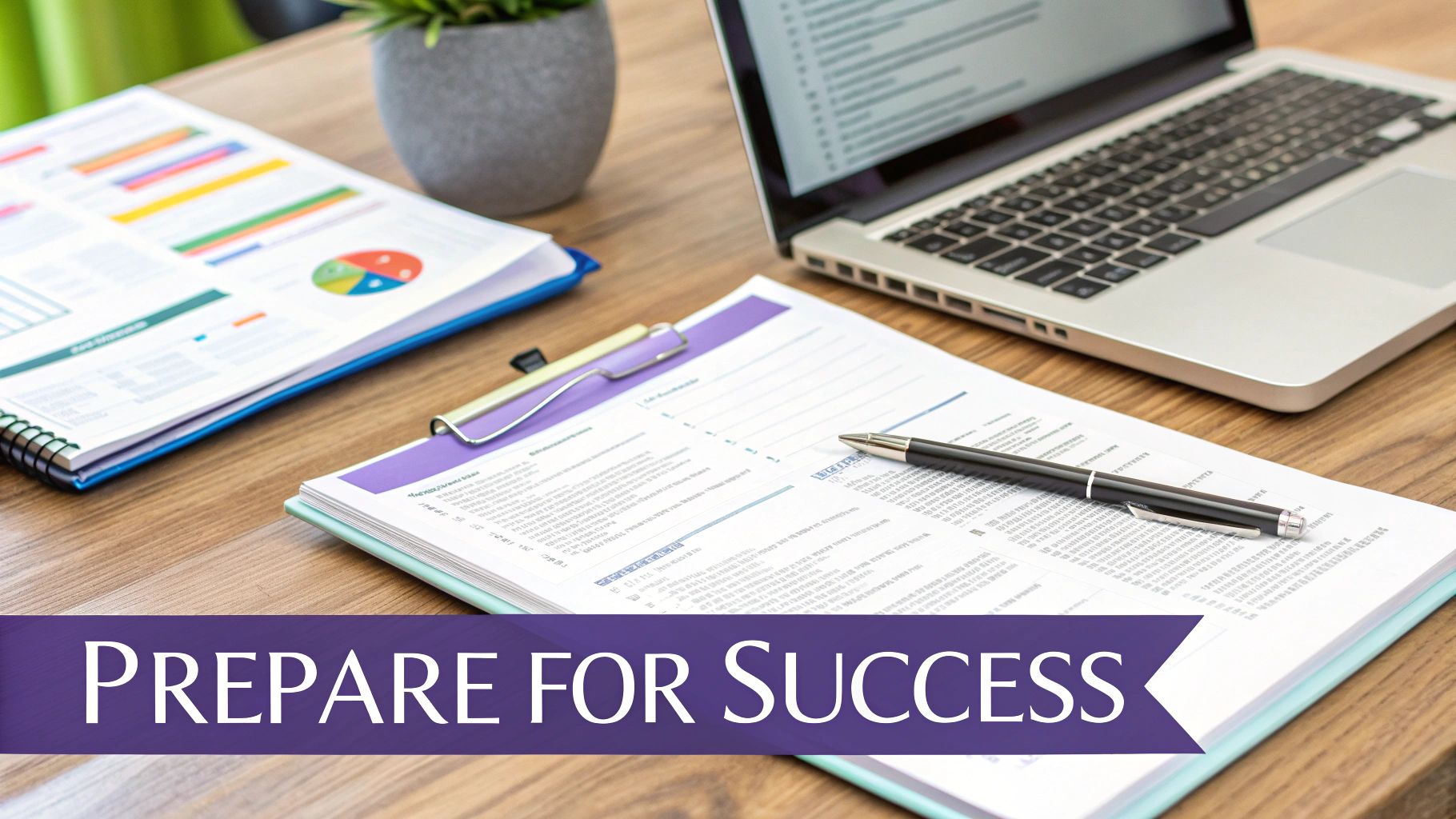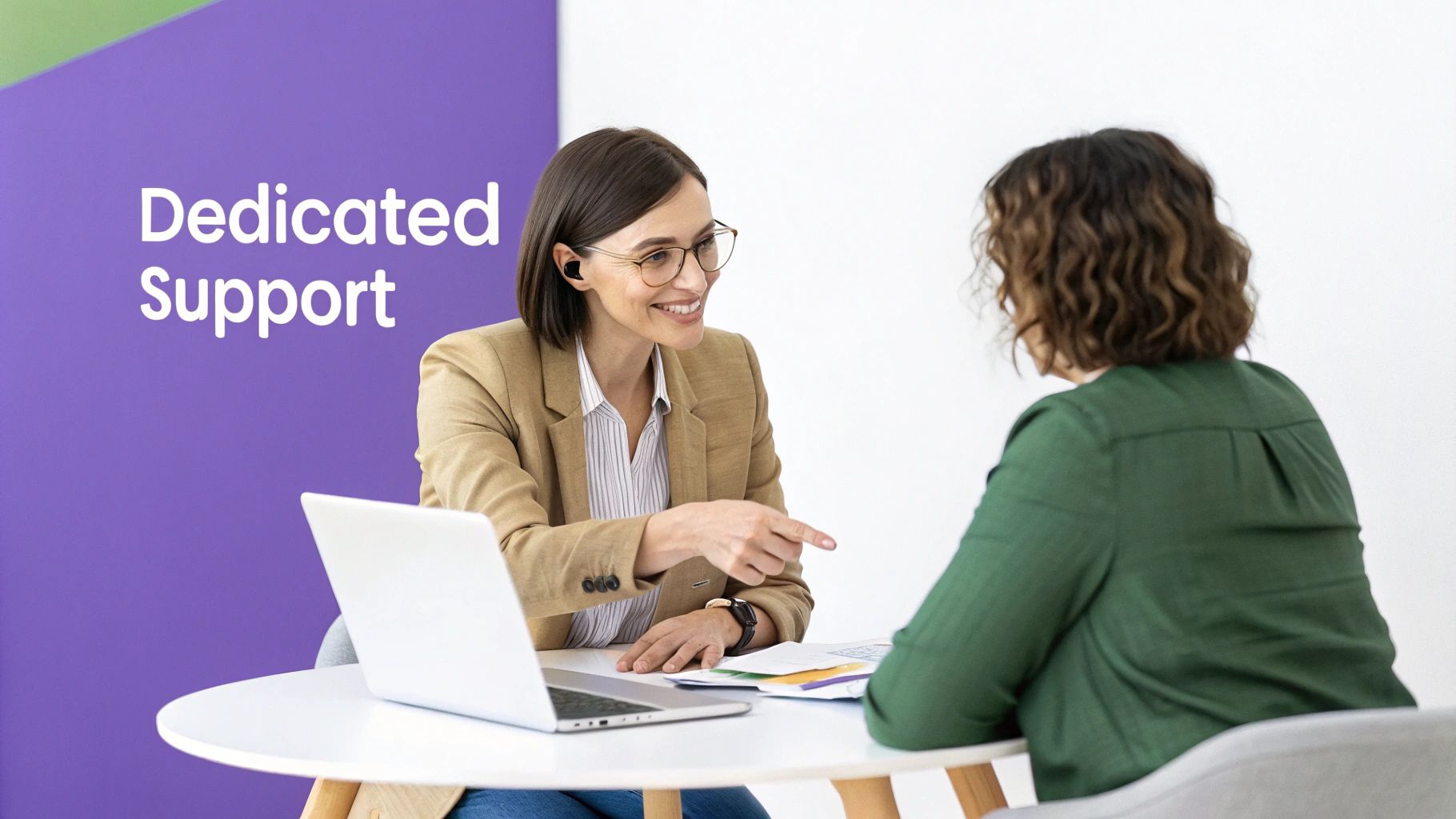
In the competitive landscape of 2025, the initial client experience isn't just a formality; it's a critical predictor of long-term loyalty and revenue. A disjointed or confusing onboarding process can quickly lead to disengagement, frustration, and ultimately, churn. Conversely, a well-executed onboarding journey sets the stage for rapid value realization, strong client relationships, and enthusiastic brand advocacy. For Customer Success (CS) teams, mastering this initial phase is paramount. It’s the first, and perhaps most important, opportunity to prove your product's value and demonstrate your commitment to the client's success.
This article dives deep into eight essential client onboarding best practices, providing actionable, detailed strategies that move beyond generic advice. We will explore how to transform your onboarding from a simple checklist into a strategic advantage that drives engagement and cements retention from day one. To truly master that crucial first impression, consider exploring the tangible benefits of using video calls for customer onboarding.
You will learn how to implement structured and personalized strategies covering every stage of the initial customer journey. The focus is on practical application, not just theory. The goal is to equip your team with the tools needed to create a seamless, value-driven experience that turns new customers into long-term partners.
We will cover the following key practices in detail:
The most effective client onboarding best practices begin long before the official kickoff meeting. This crucial preliminary phase, known as pre-boarding, is where you lay the foundation for a seamless and successful client journey. It involves all the behind-the-scenes work your team completes between the moment a client signs the contract and the first official interaction. The primary goal is to eliminate friction and demonstrate immediate value by being thoroughly prepared.

This proactive approach sets a positive tone, showing the client they are a priority. By front-loading administrative and technical setup, you ensure the kickoff call is dedicated to strategy and building rapport, not troubleshooting access issues or chasing down paperwork.
A structured pre-boarding process transforms the initial client experience from reactive to proactive. It prevents the dreaded "post-sale silence" where a new customer's excitement can wane due to a lack of communication. Instead of scrambling, your team appears organized, efficient, and ready to deliver on its promises from day one.
Key Insight: A well-executed pre-boarding phase is the first tangible proof of your company's competence and commitment, turning a transactional sale into a relational partnership before the official onboarding even starts.
To build a robust pre-boarding workflow, focus on standardization and automation. This ensures consistency and efficiency, regardless of the client or the assigned Customer Success Manager (CSM).
Once pre-boarding is complete, the next step in delivering exceptional client onboarding best practices is to guide the customer through a structured welcome process. This approach moves beyond a single kickoff call, breaking down the entire onboarding journey into clear, manageable phases defined by specific milestones. It provides clients with a transparent roadmap, setting clear expectations for what will happen, when it will happen, and what their role is in the process.

This method demystifies the path to value realization for the client. By establishing a shared plan with tangible checkpoints, you transform an overwhelming process into a series of achievable steps, building momentum and confidence along the way. Companies like Zendesk and Shopify use this to great effect, providing enterprise clients with detailed implementation roadmaps that outline every stage, from technical setup to team-wide adoption.
A well-defined process with milestones provides accountability for both your team and the client. It prevents scope creep, keeps the engagement on track, and creates regular opportunities to demonstrate progress and celebrate small wins. This structured communication prevents the client from feeling lost or uncertain about what comes next, reinforcing their decision to choose your solution.
Key Insight: A milestone-driven onboarding plan acts as a mutual success agreement. It turns abstract goals into a concrete project plan, aligning both teams on the specific actions required to achieve the desired outcomes.
To implement this effectively, think like a project manager. Your goal is to create a repeatable yet flexible framework that guides clients from initial setup to first value.
As your client base grows, a "one-size-fits-all" approach where every Customer Success Manager (CSM) handles the entire lifecycle becomes less effective. A superior client onboarding best practice is to establish a dedicated team or specialist focused exclusively on the initial onboarding phase. These experts guide new customers through the critical first 30, 60, or 90 days, ensuring they achieve early wins and build a strong foundation for long-term success.

This model allows for deep specialization. Onboarding specialists become masters of the initial setup, common implementation hurdles, and user adoption strategies. This focused expertise leads to a more efficient, repeatable, and effective onboarding experience than what a generalist CSM, who is juggling renewals and escalations, can typically provide.
Assigning dedicated specialists transforms onboarding from a procedural checklist into a strategic, value-driven function. These teams are not just project managers; they are adoption drivers. This structure is particularly vital for companies with complex products, like enterprise software vendors such as Workday or Gainsight, where specialized implementation guidance is non-negotiable for client success.
Key Insight: A dedicated onboarding specialist acts as a client's "first friend" at your company, providing focused, expert guidance that accelerates time-to-value and sets the stage for a smooth handoff to the long-term CSM.
Building an effective dedicated onboarding function requires clear processes and the right talent. The goal is to create a seamless bridge from sales to full product adoption, managed by a team of experts.
While personalized guidance is essential, one of the most powerful client onboarding best practices is empowering customers to help themselves. A comprehensive documentation and resource hub is a centralized, on-demand knowledge base that gives clients instant access to tutorials, guides, and answers. This repository acts as a digital mentor, available 24/7 to support users as they navigate your product or service.

By providing robust self-service options, you reduce dependency on your support team for common queries and allow clients to learn at their own pace. This approach, pioneered by developer-focused companies like Stripe and now a standard for leading SaaS platforms, demonstrates a commitment to user enablement and long-term success.
A well-organized resource hub scales your customer success efforts and caters to different learning styles. It transforms the onboarding process from a finite series of meetings into a continuous learning journey. Clients who can find answers quickly feel more competent and are less likely to experience friction that could lead to churn.
Key Insight: A searchable, comprehensive resource hub doesn't replace your Customer Success team; it supercharges it. By handling foundational questions, it frees up your CSMs to focus on high-value, strategic conversations that deepen the client relationship.
Building an effective knowledge base requires strategic organization and a commitment to maintenance. The goal is to make information discovery effortless for a new user.
Effective client onboarding is not a "set it and forget it" process. One of the most critical client onboarding best practices is establishing a structured cadence of check-ins and formal progress reviews. These scheduled touchpoints create a continuous feedback loop, ensuring the client remains engaged, stays on track with their goals, and feels supported long after the initial kickoff. The primary goal is to proactively monitor health, address emerging challenges, and reinforce the value of your partnership.
This consistent communication prevents minor issues from escalating into major roadblocks. By regularly assessing progress against predefined milestones, you can demonstrate tangible ROI throughout the onboarding journey, keeping momentum high and solidifying the client's confidence in their decision.
A structured check-in strategy transforms onboarding from a linear checklist into a dynamic, responsive partnership. It provides dedicated opportunities to gather feedback, recalibrate the plan based on new information, and ensure alignment between your team's activities and the client’s evolving business objectives. This approach is fundamental to identifying at-risk accounts early and implementing corrective measures.
Key Insight: Regular, purposeful check-ins are the lifeblood of a healthy client relationship during onboarding. They shift the dynamic from a simple service delivery to a collaborative journey toward shared success, significantly boosting long-term retention.
To implement an effective review cadence, focus on purpose, preparation, and flexibility. The format and frequency should adapt to the client's complexity and needs, moving beyond generic "just checking in" calls.
A generic, one-size-fits-all training approach during onboarding often leads to disengagement and poor adoption. The best client onboarding practices recognize that different users have different roles, technical skills, and learning preferences. Personalized training and education programs address this by tailoring content, format, and pacing to the specific needs of each client segment or user persona.
This customization ensures that every user receives the most relevant information needed to perform their job effectively using your product. Instead of overwhelming an executive with technical minutiae or boring a power user with basic features, you deliver targeted knowledge that accelerates their time-to-value and builds their confidence in your solution.
Tailored education transforms onboarding from a passive information dump into an active, engaging learning experience. It demonstrates a deep understanding of the client's business and its unique operational needs, reinforcing the value of the partnership. When users feel the training is built specifically for them, they are more likely to participate, retain information, and successfully adopt the product into their daily workflows.
Key Insight: Personalization in training is a powerful retention strategy. It directly impacts user competence and confidence, which are the foundational pillars of long-term product adoption and customer loyalty.
To implement personalized training, you must first understand your users' needs and then build a flexible educational framework to meet them. This requires moving beyond a single webinar or a lengthy PDF guide.
Scaling a high-touch onboarding experience requires a smart blend of human expertise and technological efficiency. Technology-enabled automation streamlines the repetitive, administrative aspects of client onboarding, allowing your Customer Success team to focus on strategic guidance and relationship building. This practice involves using software to automate workflows, trigger communications, and track client progress, ensuring a consistent and error-free experience for every customer.
The goal is not to replace the human element but to enhance it. By automating tasks like sending welcome emails, assigning setup tasks, and scheduling check-ins, you free up your team’s capacity. This allows them to dedicate more time to high-value activities that automation cannot replicate, such as understanding a client’s unique business challenges or providing personalized strategic advice.
As your client base grows, manual onboarding processes become a significant bottleneck. They are prone to human error, lead to inconsistent client experiences, and consume valuable CSM time. Automation solves this by creating a standardized yet flexible framework that executes flawlessly every time, ensuring no client falls through the cracks.
Key Insight: Effective onboarding automation acts as a force multiplier for your Customer Success team. It handles the predictable, low-value tasks, empowering your team to deliver exceptional, high-value strategic support that drives long-term loyalty and retention.
Introducing automation should be a strategic, phased process. Start small and build complexity as your team and systems mature. The best client onboarding best practices integrate technology thoughtfully.
The best client onboarding programs are not static; they are living, evolving systems that adapt to changing client needs and business goals. This evolution is driven by a commitment to continuous feedback collection and process improvement. It involves systematically gathering insights from new clients throughout their onboarding journey and, crucially, acting on that data to refine and enhance the experience for future customers.
Treating onboarding as a product that requires constant iteration is one of the most powerful client onboarding best practices you can adopt. Instead of waiting for an annual review, this approach embeds improvement into your operational rhythm, allowing you to quickly identify friction points, double down on what works, and demonstrate to clients that their voice matters.
A "set it and forget it" mentality is a direct path to an outdated and ineffective onboarding process. By creating formal feedback loops, you transform anecdotal evidence into actionable data. This data-driven approach allows you to move beyond assumptions and make informed decisions that directly impact client satisfaction, time-to-value, and long-term retention.
Key Insight: Onboarding is not a one-time project; it's a continuous improvement cycle. Actively seeking and implementing client feedback is the engine that drives its optimization, ensuring it remains relevant and effective.
To build a culture of continuous improvement, you need to integrate feedback mechanisms directly into the onboarding workflow and establish a clear process for analyzing and acting on the results.
The journey from a newly signed contract to a deeply engaged, loyal customer is paved with the deliberate, strategic actions you take during onboarding. We've navigated through a comprehensive blueprint of client onboarding best practices, moving from critical pre-boarding preparation and structured welcome processes to the necessity of dedicated specialists and robust resource hubs. We've also highlighted the power of personalized training, consistent communication, technology-driven automation, and a commitment to continuous improvement through feedback.
This isn't just a checklist to be completed; it's a foundational philosophy. A truly exceptional onboarding experience is the first, and arguably most crucial, demonstration of your brand's promise. It’s where you transform the value proposition sold by your sales team into a tangible reality for your new client. Getting this stage right sets a powerful precedent, fostering trust and demonstrating that you are a partner invested in their success, not just a vendor who has closed a deal.
The transition from understanding these concepts to implementing them requires a structured approach. The sheer volume of best practices can feel overwhelming, but progress is made through incremental, focused improvements. Avoid the temptation to overhaul your entire process overnight. Instead, adopt an iterative mindset.
Here are your actionable next steps to transform your client onboarding:
Conduct a Comprehensive Audit: Begin by objectively evaluating your current onboarding process against the eight pillars discussed in this article. Where are your most significant gaps? Are you missing a dedicated resource hub, or are your check-ins inconsistent and reactive? Use a simple scoring system (e.g., 1-5) for each area to identify your weakest links.
Prioritize for Maximum Impact: You cannot fix everything at once. Select the one or two areas from your audit that will deliver the most significant immediate value to your clients. For example, if initial confusion is high, focus on creating a structured welcome process with clear milestones. If clients are failing to adopt key features, prioritize personalized training programs.
Develop a Concrete Action Plan: For your chosen priority, outline specific, measurable, achievable, relevant, and time-bound (SMART) goals. Who owns this initiative? What resources are needed? What does success look like in 30, 60, and 90 days? Document this plan and secure buy-in from key stakeholders across your organization.
Leverage Technology for Scalability: As you refine your process, recognize the limits of manual effort. True efficiency and a consistently high-quality experience at scale are only possible with the right technology. Look for platforms that can automate repetitive tasks, provide deep insights into client health, and enable your team to be proactive rather than reactive.
Mastering these client onboarding best practices is more than just a customer service initiative; it's a core business strategy. A seamless onboarding process directly correlates with higher product adoption, faster time-to-value, reduced churn, and an increased likelihood of expansion revenue. It empowers your Customer Success team to move beyond firefighting and troubleshooting, allowing them to become the strategic advisors your clients need to achieve their goals.
By investing in a world-class onboarding system, you are not just welcoming new clients; you are building the foundation for enduring partnerships. You are creating advocates who will not only stay with you but will also champion your brand within their networks. This initial investment pays dividends throughout the entire customer lifecycle, proving that the first 90 days are often the most important in a long and profitable relationship.
Ready to automate the heavy lifting and empower your team to deliver a world-class onboarding experience? Statisfy is an AI-driven platform that streamlines data integration, monitors client health in real-time, and provides the proactive insights you need to turn best practices into reality. Discover how you can build a scalable, repeatable, and effective onboarding engine by visiting Statisfy today.